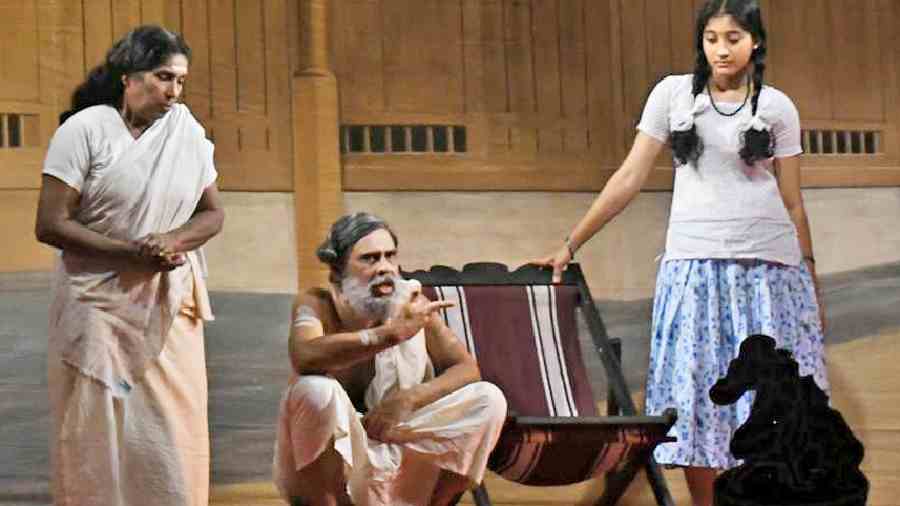A cold December night in 1952. Chavara, a seaside village in Kerala’s Kollam district. Since evening, people are flocking to Sudarsana Theatre, a coconut leaf-thatched cinema hall at the Thattassery Maidan, to watch a new play. Although excited, they hardly knew they were about to witness something that would change history. But the organisers were worried about a few policemen dressed in civils and some hoodlums in the audience who might disrupt the play.
However, once the curtains rose, everyone sat bewitched. From its beginning, the gripping play mirrored their lives engagingly. It had an intense love story, pithy humour, brilliant acting, and captivating music. Yet, at its core, it was something new — a passionate call to rise against exploitation by landlords. The audience was thrilled by the brave hero, Comrade Gopalan, who mobilised the villagers to fight against their tormentors. In the climax, when Gopalan’s father, Paramu Pillai, an impoverished, former landlord who had once fiercely opposed his son, gets fully converted and lifts a red flag shouting, “I am also a communist,” the audience was rapturous. Rising to their feet, they begin shouting, ‘Inquilab zindabad!’ Among those who applauded were some of the hired disruptors.
The village witnessed the very first staging of the legendary play, Ningalenne Communistakki (You made me a Communist), which is still popular in Kerala even as it celebrates its 70th anniversary. The play was an instant hit despite attacks on its organisers and performers by the police and other vested interests to prevent its staging. It was on the vanguard of the unified Communist Party of India’s propaganda blitzkrieg during 1957’s assembly elections that saw India’s first communist government coming to power in Kerala. Its role in the historic event was later mentioned by E.M.S. Namboodiripad, the communist leader who was elected chief minister.
The play was staged by the Kerala People’s Arts Club, formed under the unified CPI in 1950, which soon became the state’s most successful drama troupe. During its first staging, the play’s author was shown as Soman, a pseudonym for Thoppil Bhasi, who was then being hunted by the police in connection with a violent communist uprising in his village, Sooranad. The proceeds from the first staging were used to meet the litigation costs to free Bhasi and the other accused in the case. Bhasi, who later became Kerala’s most prominent dramatist, scriptwriter and film-maker, was also among the elected CPI MLAs in 1957. “The play was booked on the inaugural day itself to be staged in 37 places,” says Byju Chandran, whose new book on the play and one of its legendary singers, KPAC Sulochana, is to come out to mark the 70th anniversary. KPAC has continuously produced similar political plays, with Bhasi penning 16 (he also wrote scripts for 110 films) until he passed away in 1992. Besides helping the CPI come to power, the KPAC and the play contributed to the Left’s continuing cultural hegemony in Kerala, irrespective of its political ups and downs.
Most of those associated with the KPAC were debutantes who became legends later. Two key performers were already young communist legislators and its young lyricist, O.N.V. Kurup, and the composer, G. Devarajan, became Malayalam cinema’s most sought-after team. Kurup later rose to become Malayalam’s foremost poet and won the Jnanpith in 2007 and the Padma Vibhushan in 2011. The play’s songs are lapped up even by today’s generation. ONV, as he came to be known, wrote later, “It was staged first on that wintry December night in my village and captivated the audience from the beginning. It truly echoed the collapse of the feudal system and the rising of the oppressed. Walking back to my home with Devarajan after the play, we felt the moon shone ever brighter on that midnight.” The classic ONV-Devarajan song, “Ponnarival ambiliyil” (The Golden Sickle), still resonates even with generations born much later, cutting across divides.
The KPAC and the play followed in the footsteps of the famed Indian People’s Theatre Association, formed in 1943 in Mumbai by leftwing nationalists and creative artists. This followed the decision in the Congress’s Lucknow session to build a progressive cultural movement to enlighten the people about India’s rich artistic tradition and enhance their nationalistic spirit. Led by reputed artists and writers like Krishan Chander, Ali Sardar Jafri, K.A. Abbas, Prithviraj Kapoor, Ritwik Ghatak, Utpal Dutt, Balraj Sahni and Uday Shankar, among others, the IPTA called for secularism, socialism, gender equality and so on. Its first significant play was the riveting Nabanna (Fresh Harvest, 1944) in Bengali by Bijon Bhattacharya on the manufactured famine of Bengal. It was made into a film, Dharti Ke Lal, by Abbas. The IPTA led a country-wide campaign focusing on the Bengal famine with Wamiq Jaunpuri’s great Urdu song, “Bhuka hai Bangal”. Similar groups and creative works came from Bengal, Andhra Pradesh and Kerala.
Even though the KPAC followed the IPTA’s example, Kerala’s tradition of political theatre dates back even further. Kerala’s legendary Reform Movement within the Namboodiri Brahmin community in the 1920s and 1930s, led by young radicals like Namboodiripad and V.T. Bhattathiripad, was fuelled by revolutionary plays on social issues. Bhattathiripad’s Adukkalayil Ninnu Arangathekku (From Kitchen to Centre Stage, 1929), on the rights of the exploited Namboodiri women, was a bombshell. In 1938, K. Damodaran, a founder of the Kerala CPI and a prominent writer, wrote Pattabakki on the rights of the exploited tenant farmers, which is seen as the first proper Marxist political play. This was followed by the formation of organisations of progressive writers and artists and the emergence of several plays, novels and poems focussing on national independence, socialist and communist ideals, the rights of the toiling masses and so on. So much so that the 1950s became known as the ‘aruna dasakam’ (the red decade) in Kerala’s cultural history.
The Left continued to have its cultural sway in Kerala, but its opponents have often challenged it too. When Ningalenne Communistakki was being staged, the Congress came out with counter-plays critiquing communism, but they had a lesser impact. Communism’s friends-turnedfoes, like the Hungarian writer, Arthur Koestler, were brought to Kerala to campaign by anti-Communist intellectuals. In 1995, a storm was created when Civic Chandran, a pro-Maoist writer, produced a counter-play, Ningal Aare Communistakki? (Whom did you make a Communist?), rubbishing Kerala’s communists as anti-Dalit and patriarchal.
The CPI(M) and the CPI continue to be more active in the cultural field than other parties. But even Left thinkers feel the movement has fallen behind on this count in recent times. They cite the rising religious and caste obscurantism, as exposed in the anti-women Sabarimala movement or the recent incident of human sacrifice, as examples of the Left’s failures on the cultural front. The historian, K.N. Panikkar, told this writer in an interview some time ago, “Despite the state’s modern and progressive exterior, it has a very conservative and regressive mindset and value system buttressed more by the increasing middleclassisation of society. There is a disjunction between political modernism and cultural modernism. Unlike in the 1940s and the 1950s, the Left has failed miserably to intervene effectively in Kerala’s culturalscape and mutely witnessed its return to conservatism.”
M.G. Radhakrishnan, a senior journalist based in Thiruvananthapuram, has worked with various print and electronic media organizations










